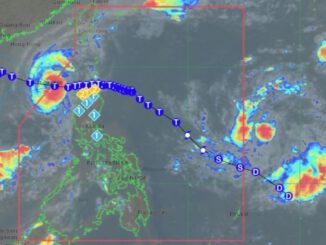
Homeowners in the northern Philippines used spades and rakes to clear out debris left by Severe Tropical Storm Kristine (international name: Trami) on Friday while rescuers trawled through thick mud looking for the missing as the death toll rose to 76.
Tens of thousands of people were displaced by floods fueled by a torrential downpour that dumped two months’ worth of rain over just two days in some areas.
“Many are still trapped on the roofs of their homes and asking for help,” Andre Dizon, police director for the hard-hit Bicol region, told AFP. “We are hoping that the floods will subside today since the rain has stopped.”
But accessibility remained a major issue for rescuers Friday, particularly in Bicol, President Ferdinand Marcos Jr. said.
“That’s the problem we’re having with Bicol, so difficult to penetrate,” he said, adding that the heavily saturated ground led to “landslides in areas that didn’t have landslides before.”
‘Everything is gone’
In Laurel, a scenic town nestled near volcanic Lake Taal south of the capital Manila, AFP reporters saw roads blocked by felled trees, vehicles half-submerged in mud and homes severely damaged by flash flooding.
“We saw washing machines, cars, home equipment, roofs being swept away,” Mimie Dionela, 56, told AFP.
“We’re lucky (the rain) happened in the morning, for sure many would’ve died if it happened at night,” she said. “It was indescribable how scared we were.”
Islao Malabanan, 63, agreed he was alive only because the flood occurred during daytime, but said his family had lost everything “including our clothes”.
Jona Maulion, who started an auto repair business in Laurel less than a year ago, questioned if her family could afford to restart from scratch.
“We thought we were on the way to success in the business,” the 47-year-old said. “I didn’t know that this would happen, everything is gone.”
Death toll grows
As Trami departed the Philippines in the early hours, traveling west over the South China Sea, the storm’s death toll was swelling as fresh reports of victims emerged.
In Batangas province south of Manila, the number of confirmed dead had risen to 43, provincial police chief Jacinto Malinao told AFP.
Laurel and the nearby towns of Talisay and Agoncillo accounted for most of the dead in Batangas, with 16 others missing in Talisay, he added.
“The greatest challenge here really is the thick mud. In our location, the mud is about 10 feet (three metres) high with debris and boulders, Malinao said.
“Hopefully, there will be no rain in the coming days so we can find the bodies fast.”
Police in the Bicol region on Friday reported 29 deaths, while four other bodies were found elsewhere.
At his morning press briefing, Marcos noted that the Bicol cities of Naga and Legazpi had reported “many casualties, but we haven’t been able to get in yet”.
‘Two months’ worth of rain
Government offices and schools across the main island of Luzon remained shuttered Friday, but storm surge warnings were cancelled along the west coast as Trami flew farther out to sea.
State weather agency specialist Jofren Habaluyas told AFP that Batangas province had seen “two months’ worth of rain”, or 391.3 millimeters, fall over October 24 and 25.
An official tally late Thursday reported nearly 320,000 people evacuated in the face of flooding that turned streets into rivers and half-buried some towns in sludge-like volcanic sediment set loose by the storm.
Rescuers in Naga City and Nabua municipality used boats to reach residents stranded on rooftops, many of whom sought assistance via Facebook posts.
The search for a missing fisherman whose boat sunk in the waters off Bulacan province west of Manila, meanwhile, remained suspended Friday due to strong currents, the local disaster office said.
About 20 big storms and typhoons hit the Philippines or its surrounding waters each year, damaging homes and infrastructure and killing dozens of people.
A recent study showed that storms in the Asia-Pacific region are increasingly forming closer to coastlines, intensifying more rapidly and lasting longer over land due to climate change. — Agence France-Presse





Be the first to comment